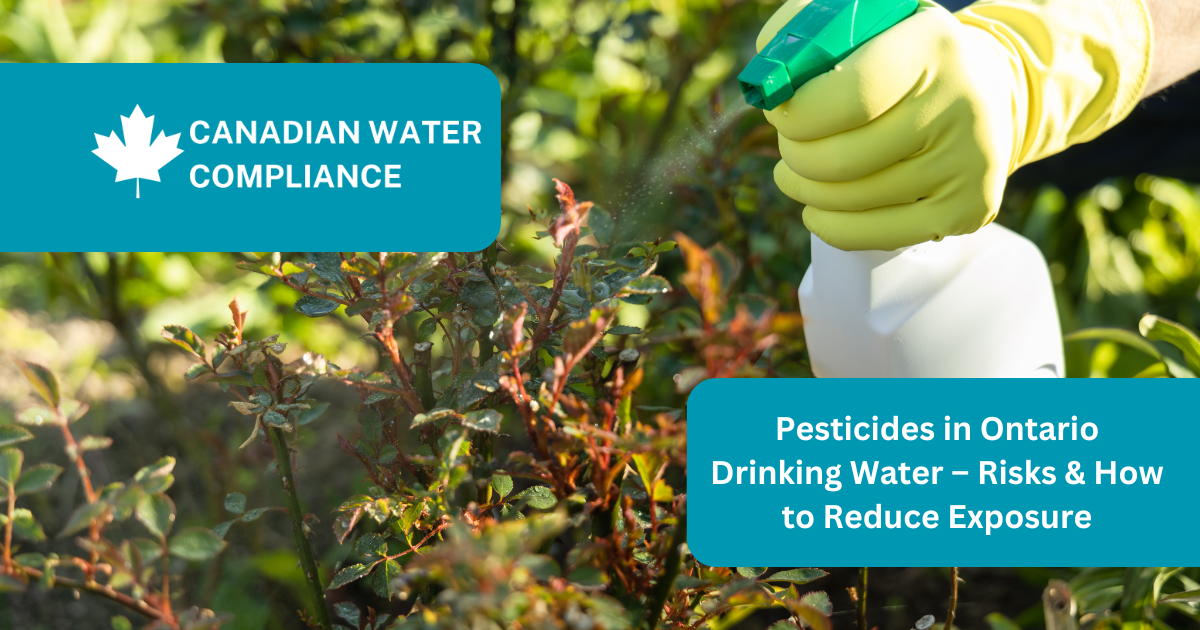
Written By: Canadian Water Compliance | On
Pesticides play a crucial role in agriculture by controlling pests and increasing crop yields. However, their widespread use raises concerns about water contamination, particularly in Ontario, where both rural and urban communities rely on groundwater and surface water sources for drinking. Pesticide runoff from farms, lawns, and golf courses can seep into rivers, lakes, and wells, posing potential risks to human health.
In this guide, we’ll cover:
✔ How pesticides enter Ontario’s drinking water
✔ The health risks associated with long-term exposure
✔ Ontario’s regulations on pesticide levels in water
✔ Steps to reduce pesticide contamination risks
Pesticides can enter drinking water sources through several pathways:
Ontario has a large agricultural industry, with widespread pesticide use in crops such as corn, soybeans, and fruit orchards. When it rains, excess pesticides wash off fields into nearby lakes, rivers, and groundwater.
Pesticides are not just used on farms. Homeowners, businesses, and municipalities apply pesticides to lawns, parks, and golf courses. These chemicals can seep into groundwater or be carried into storm drains, eventually reaching drinking water sources.
Some industries use pesticides for pest control in warehouses, manufacturing plants, and food storage facilities. Improper disposal or accidental spills can lead to localized contamination of water supplies.
Certain pesticides have high mobility in soil, meaning they can penetrate deep underground and contaminate groundwater, a major drinking water source in many parts of Ontario.
Long-term exposure to pesticides, even at low levels, can pose serious health risks:
🚨 Neurological Effects – Some pesticides have been linked to neurodevelopmental disorders, particularly in children. Studies suggest exposure may increase the risk of ADHD, cognitive impairments, and developmental delays.
🚨 Endocrine Disruption – Certain pesticides act as hormone disruptors, interfering with the body’s endocrine system. This can lead to fertility issues, thyroid disorders, and increased cancer risks.
🚨 Increased Cancer Risk – Herbicides like atrazine and glyphosate have been classified as possible carcinogens. Long-term consumption of contaminated water may increase the risk of leukemia, lymphoma, and other cancers.
🚨 Birth Defects & Reproductive Issues – Studies suggest that prenatal exposure to certain pesticides may increase the risk of birth defects, low birth weight, and pregnancy complications.
🚨 Liver & Kidney Damage – Some pesticides are slow to break down, meaning they accumulate in the body over time, leading to potential liver and kidney toxicity.
To protect public health, Ontario enforces strict limits on pesticide levels in drinking water through the Safe Drinking Water Act, 2002. The province follows the Maximum Acceptable Concentrations (MACs) set by Health Canada’s Guidelines for Canadian Drinking Water Quality.
Common Pesticides Regulated in Ontario Drinking Water:
Atrazine – Herbicide used on corn crops (MAC: 5 µg/L)
Glyphosate (Roundup) – Common herbicide (MAC: 280 µg/L)
2,4-D – Used for weed control in lawns (MAC: 100 µg/L)
Carbaryl & Carbofuran – Insecticides found in agricultural runoff (MAC: 90 µg/L & 20 µg/L)
Chlorpyrifos – Linked to neurodevelopmental risks (MAC: 90 µg/L)
💡 Public water systems in Ontario must test for these pesticides regularly, but private well owners are responsible for their own testing.
✔ Test Your Water Regularly – If you live near farms or use well water, test for common pesticides and herbicides at least once a year.
✔ Use Certified Water Filters – Reverse osmosis and activated carbon filters can remove pesticide residues from drinking water.
✔ Choose Pesticide-Free Lawn Care – Opt for natural alternatives like composting and integrated pest management.
✔ Prevent Runoff – Avoid applying pesticides before rain and keep them away from driveways and storm drains.
✔ Follow Ontario’s Best Practices for Pesticide Use – Use buffer zones, crop rotation, and precision spraying to minimize runoff.
✔ Implement Cover Crops & Buffer Strips – Planting grasses and trees around water bodies can absorb excess pesticides before they reach waterways.
✔ Use Low-Impact Pesticides – Choose biodegradable and less toxic pesticides whenever possible.
✔ Properly Store & Dispose of Pesticides – Prevent spills and leaks by keeping pesticides away from water sources.
✔ Monitor & Reduce Pesticide Use in Public Spaces – Parks, golf courses, and landscaping companies should limit pesticide application and explore organic alternatives.
✔ Improve Stormwater Management – Investing in bioswales and retention ponds can help filter out pesticides before they reach drinking water supplies.
✔ Support Local Water Protection Initiatives – Programs like Ontario’s Source Water Protection Plans help safeguard drinking water from contaminants, including pesticides.
Pesticide contamination in drinking water is a serious concern, particularly in agricultural and urban areas of Ontario. While regulations exist to limit pesticide levels, contamination can still occur due to runoff, leaching, and improper use.
💧 By testing your water, using proper filtration, and reducing pesticide use, homeowners, businesses, and municipalities can help protect Ontario’s drinking water.
🔎 Concerned about pesticides in your water? Contact Canadian Water Compliance for professional water testing and filtration solutions.